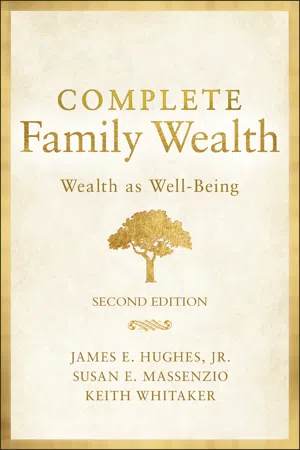
Complete Family Wealth
Wealth as Well-Being
- English
- ePUB (mobile friendly)
- Available on iOS & Android
About this book
A primer for families of high net worth on how to manage their qualitative and financial wealth for generations
The second edition of this foundational work, Complete Family Wealth: Wealth as Well-Being provides proven tools and best practices for families of means to use in maturing, maintaining, and managing personal and legacy wealth long into the future. The book is divided into three parts: the "what"—what is meant by family, wealth, and enterprise; the "who"—the persons crucial to family enterprise flourishing; and the "how"—specific practices families can use to enhance and grow family wealth.
The second edition of this work places the health and well-being of the individual members of the family unit at the forefront of every aspect detailed within the book. A natural product of this focus is an increased awareness of the social complexities of wealth that have come to the fore in recent years, and the team of expert authors here address the responsibility of private wealth to the public good. In addition, Complete Family Wealth 's second edition provides readers with:
- A new chapter on "the big reveal, " suggesting ways to encourage positive, life-affirming reception of the revelation of present or future wealth
- An additional chapter on preserving the beloved family vacation home
- Two new appendices: "Fiduciary Course Curriculum, " dedicated to enhancing the education of trustees and beneficiaries; and "Key Practices for Families During Challenging Times, " a response to the pandemic but relevant to all trying periods for families
- Examples that make these practices accessible to a broad audience across the wealth spectrum.
Having shaped the language used by families and their advisors with the first edition, Complete Family Wealth 's second edition is essential reading for families of high net worth and their financial advisors. It will also be of interest to family offices, fund managers, as well as private investors.
Frequently asked questions
- Essential is ideal for learners and professionals who enjoy exploring a wide range of subjects. Access the Essential Library with 800,000+ trusted titles and best-sellers across business, personal growth, and the humanities. Includes unlimited reading time and Standard Read Aloud voice.
- Complete: Perfect for advanced learners and researchers needing full, unrestricted access. Unlock 1.4M+ books across hundreds of subjects, including academic and specialized titles. The Complete Plan also includes advanced features like Premium Read Aloud and Research Assistant.
Please note we cannot support devices running on iOS 13 and Android 7 or earlier. Learn more about using the app.
Information
PART ONE
CHAPTER 1
Complete Wealth
Right Understanding
Complete Wealth
The Five Types of Qualitative Capital
Human Capital

Legacy Capital
Family Relationship Capital
Structural Capital
Social Capital
Financial Capital
Growing Capital
Human Capital
- Promote each member's individual flourishing. (For more on the psychological aspects of individual flourishing, see the Conclusion.) This includes providing the best possible medical care to every family member whose pursuit of happiness is blocked by addiction or physical or mental illness.
- Ensure that every family member's basic requirements for food, shelter, and clothing are met, and for members who experience a life emergency, that those needs are met at a level adequate to allow them to regain the capacity for the pursuit of individual happiness.
- Emphasize the importance of work to an individual's sense of self-worth and assist each family member in finding...
Table of contents
- Cover
- Table of Contents
- Title Page
- Copyright
- Dedication
- Epigraph
- Preface to the Second Edition
- Preface to the First Edition
- INTRODUCTION: An Invitation
- PART ONE
- PART TWO
- PART THREE
- CONCLUSION: Individual Flourishing
- EPILOGUE: The Future?
- Appendix One: Fiduciary Course Curriculum
- Appendix Two: Key Practices for Families During Challenging Times
- About the Authors
- Index
- End User License Agreement